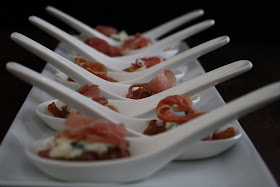By next year at this time most of us will still be able to remember who won the Oscar for best actress and best actor. However, the names of the Oscar winning best supporting actress and/or best supporting actor may be permanently stuck to the tips of some of our tongues. Similarly we have great powers of recall when it comes to remembering the main course of a meal, but a sketchier, more selective memory for the sides served. When someone asks us to describe a holiday, birthday, or other celebratory meal, we often lead with the main course. Most restaurants list the available sides in some obscure place on the menu, often in a smaller font. Just as a movie becomes more compelling with a great support cast, a meal feels complete with sides, particularly the 'we want second helpings' kind.
This Creamy Cornbread Casserole, part cornbread and part custard in texture, it is everything a corn pudding was meant to be. As the perfect accompaniment to grilled or roasted poultry, grilled steaks, and even a bowl of hearty chili, it is a side dish having a 'must have a second helping' quality.
For those of you having an aversion to making any casserole with canned corn, you may be tempted to say 'thanks but no thanks'. While I can appreciate the strong desire to cook only with fresh ingredients (I too have my 'fresh is best' moments), this Creamy Cornbread Casserole may cause your canned food paradigm to shift.
Added to the can of creamed corn and whole kernel corn (undrained), are two eggs, sour cream, melted butter, heavy cream, and freshly grated cheddar cheese.
For this casserole I used Kerrygold's 12 month aged cheddar (white) as it brought just the right amount of cheesiness. If for some reason you can't find it, buy a really good one year old white cheddar. You don't need to buy a 2 or 3 year old aged cheddar for this casserole, but you do need to buy some really good parmigiano-reggiano to give it a slight nuttiness. More on that in a bit.
Making up the dry ingredient portion of the casserole is all-purpose flour, kosher salt, sugar, baking powder, and cornmeal. I used Bob's Red Mill medium grind stone ground cornmeal.
The assembly of the casserole is as simple as blending the wet and dry ingredients together.
The entire mixture is poured into a butter casserole pan, topped with an additional 1/4 cup of grated cheddar and 1/4 cup of freshly grated parmigiano-reggiano cheese. Considering all of the controversy surrounding pre-grated, pre-packaged parmesan cheeses going on, why risk sprinkling wood chips onto this casserole? Besides, there is a world of flavor difference between freshly grated parmigiano-reggiano cheese and any bag or boxed pre-grated cheese.
The Cream Cornbread Casserole bakes in a preheated 350 degree (F) oven for 35-40 minutes or until the top is golden brown. The center of the casserole will have some movement or wiggle in the center, however, after resting for 15-20 minutes before serving, it all comes together perfectly.
Having made other corn pudding recipes in the past, I have to say I think the recipe for this Creamy Cornbread Casserole is now my favorite. If there were ever a side dish worthy of having a starring role on your dinner table, this would be it. Unlike some of the other side dishes you have brought to your dinner table, this will definitely be one of those falling into the unforgettable ones category.
Creamy Cornbread Casserole (slight adaptation to Colorado Chef John Broening's Creamy Cornbread Casserole recipe)
Ingredients
1/2 cup all-purpose flour
3/4 cup medium grind, stone ground corn meal (Recommend Bob's Red Mill Stone Ground Cornmeal)
4 Tablespoons granulated sugar
2 teaspoons baking powder
1/2 teaspoon salt
8 Tablespoons unsalted butter, melted, cooled slightly
1 can (15.25 ounces) whole kernel sweet corn with liquid (do not drain)
1 can (14.75 ounces) creamed corn
3/4 cup sour cream
1/2 cup heavy cream
2 large eggs
1 1/2 generous cups (7 ounces) shredded aged cheddar cheese, divided (Recommend Kerrygold's 12 month old Aged Cheddar Cheese)
1/4 cup finely grated Parmigiano-Reggiano cheese
Directions
1. Preheat oven to 350 degrees (F). Butter a 11"x7" casserole dish and set aside.
2. In a large bowl, combine butter, whole kernel sweet corn with liquid, creamed corn, sour cream, heavy cream, eggs and 1 1/4 cups grated cheese until blended. Set aside.
3. In a medium sized bowl, combine all-purpose flour, cornmeal, sugar, baking powder and salt. Whisk until blended.
4. Add dry ingredients to wet ingredients and mix to blend.
5. Pour mixture into prepared casserole dish.
6. Sprinkle remaining 1/4 plus grated cheddar cheese. Top with finely grated Parmigiano-Reggiano cheese.
7. Bake 35-40 minutes or until top is golden. Note: There will still be some slight movement in the center of the casserole.
8. Remove from oven. Allow to sit at least 15-20 minutes before serving. Serve warm or at room temperature.




















































